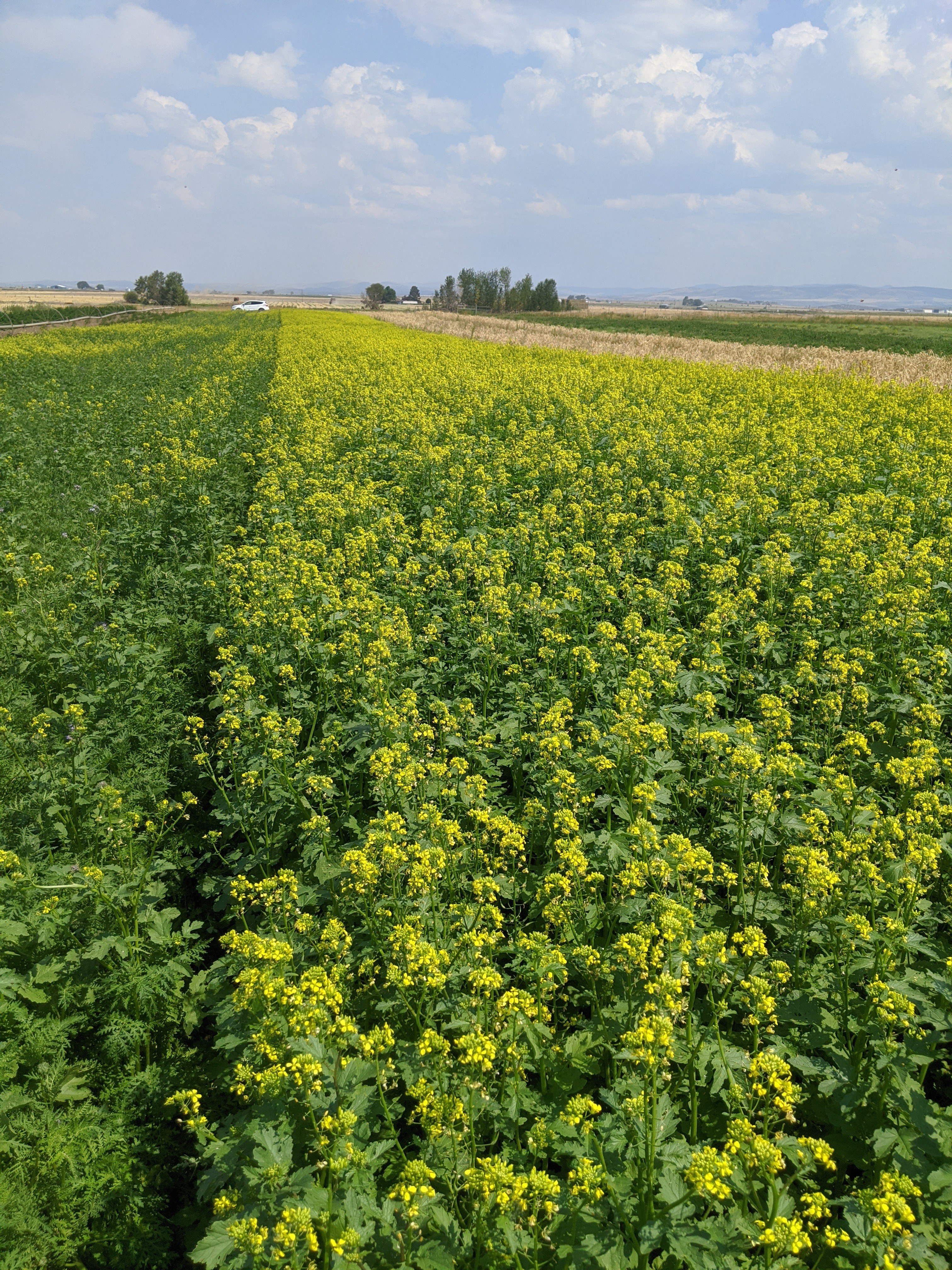Connecting the Dots Between Cover Crops, Soil Health, and Pollinator Conservation by Isabel Nazarian, Midwest Regional Partner Biologist, Pollinator Partnership
Photo: Emily Carlson, field of mustard cover crop blooming

Published November 5, 2025
In the past decade, cover crop acreage in the Midwest rose from about 1.8% of cropland to about 7.2% in 2022. Nationally, total acres of cover crops increased from 15.4 million in 2017 to 18 million in 2022, almost a 17% increase. Cover cropping is an agricultural practice in which farmers intentionally plant specific species between or alongside their main cash crops to improve soil health and protect the long-term health of their farm. Rather than leaving the field bare after harvest, cover crops keep the surface of the soil covered and living roots in the ground year-round.
From supporting soil health and delivering cost-saving services to providing much needed forage and habitat for pollinators, cover crops are increasing in popularity for good reason. Pollinators like native bees, honey bees, butterflies, as well as natural enemies of crop pests, play a critical role in crop production, but in order to be present when needed, they require landscape features that support their populations throughout the year. Thoughtful planning can provide this necessary on-farm habitat and help prevent commonly experienced seasonal shortages of nectar and pollen, particularly in early spring and late fall. Incorporating flowering cover crops into your field rotation can be a great way to bridge nutritional gaps and help sustain pollinator communities that increase pollination services for nearby cash crops. In this article, we’ll explore some of these benefits in more detail and share information about programs and resources that can help interested producers build or diversify their cover cropping system.
Strengthening soils over time
Cover crops provide a wide range of agronomic advantages. They can reduce soil erosion by maintaining ground cover, re-incorporate residual nutrients to prevent leaching, suppress weed germination, decrease crop pest populations, and increase soil organic matter that feeds the microbial community.
Legumes, like clovers, have a unique relationship with rhizobia, a nitrogen-fixing bacteria that converts atmospheric nitrogen (N2) into a plant available form (ammonia). By adding legumes into the cropping system, it can help reduce the reliance on synthetic fertilizers, saving money and time. Additionally, many legumes are attractive to pollinators as they provide pollen and nectar.
Deep-rooted species like tillage radish (Raphanus sativus) and forage turnip (Brassica rapa) can penetrate compacted soil, improving its structure and water infiltration. Over time, these changes enhance soil structure, water-holding capacity, and nutrient cycling, all of which can support greater yields. As an added benefit, certain Brassica species (cabbages and mustards) can also help with soil pest and disease suppression, including issues such as nematodes and some soil-borne pathogens.
Selecting the right plants
Photo: SARE, cover crop roots holding soil in place
Selecting the right cover crop or cover crop mix is key to maximizing both environmental and agronomic benefits. To support pollinators, selecting a blooming cover crop is vital. Crimson clover (Trifolium incarnatum) can be a good choice as it establishes quickly, fixes nitrogen, and produces early blooms that provide plenty of nectar and pollen. Red clover (Trifolium pratense) and Alsike clover (Trifolium hybridum) also fix nitrogen and can continue to bloom for longer, providing floral resources during times of scarcity while still enhancing soil fertility. Buckwheat (Fagopyrum esculentum) offers a rapid growth cycle, suppresses weeds effectively, and supports a wide array of native bees and other beneficial insects during its mid-summer bloom. Phacelia (Phacelia tanacetifolia) is highly attractive to native bees and other beneficial insects and can be incorporated as a quick-blooming species in diverse mixes. Combining species that bloom at different times will extend floral availability and deliver multiple soil functions simultaneously.
The timing of management is especially important when planting cover crops for pollinators. To provide worthwhile forage, cover crops must be allowed to bloom before termination, whether through mowing, crimping, or herbicide. Flowering cover crops can be integrated between cash crop cycles, on field edges, in buffer strips, or in fallow acreage without interfering with production schedules. Paying attention to planting dates, seeding rates, and termination windows will help ensure they complement your overall crop rotation and do not compete with cash crops for moisture or nutrients.
Healthy soils mean resilient farms
Photo: Lacey Smith, a Least Skipper (Ancyloxypha numitor) drinking nectar from blooming alsike clover (Trifolium hybirdum)

By incorporating cover crops that deliver both soil health and pollinator habitat benefits, farmers can strengthen the ecological foundation of their operation. Supporting pollinators in this way enhances on-farm biodiversity, contributes to more resilient production systems, and helps sustain the pollination and natural pest suppression services that agriculture depends on.
Farmers don’t have to take this step alone! Support is available through agencies like the USDA’s Natural Resources Conservation Service (NRCS) and their partner network. NRCS offers both technical and financial assistance for integrating cover crops, including options that support habitat for pollinators and other wildlife. Through the Environmental Quality Incentives Program (EQIP) and Conservation Stewardship Program (CSP), producers can receive cost-share and planning support that makes it easier to establish and manage cover crops effectively. Working with your local NRCS office can help you design a cover crop and overall farm strategy that can address all the resources concerns on your farm while creating habitat and protecting pollinators.
Technical Assistance Available
Photo: SARE, Farm manager and Soil Conservation agent looking at a field of tillage radish cover crop together

If you’re interested in finding out more pollinator-friendly cover crop strategies tailored to your operation, a partner biologist from Pollinator Partnership is here to help! We can provide guidance on species selection, custom seed mixes, management plans, and help you get in touch with your local NRCS field office.
To request information or learn more about pollinator conservation opportunities through Farm Bill programs, complete the appropriate form below:
Midwest Assistance Request FormNortheast Assistance Request Form
Western Assistance Request Form
NRCS Partner Biologists

Isabel Nazarian (Midwestern US)
Lacey Smith (Northeastern US)
Sophia Sorboro (Ohio)
References and Additional Resources:
- Myers, R., et al. 2020. “Opportunities for Cover Crops to Provide Habitat for Pollinators and Other Beneficial Insects in Agricultural Landscapes.” Agriculture, Ecosystems & Environment, 302: 107081.
- Midwest Cover Crops Council (MCCC). 2024. Cover Crop Decision Tool. https://www.midwestcovercrops.org
- Sustainable Agriculture Research & Education (SARE). 2017. Cover Cropping for Pollinators and Beneficial Insects. SARE Bulletin. https://www.sare.org/wp-content/uploads/Cover-Cropping-for-Pollinators-and-Beneficial-Insects.pdf
- Sustainable Agriculture Research and Education (SARE). 2022. Managing Cover Crops Profitably, 4th Edition. USDA-SARE. https://www.sare.org
- U.S. Department of Agriculture, Natural Resources Conservation Service (NRCS). 2023. Cover Crops and Soil Health. https://www.nrcs.usda.gov
- U.S. Department of Agriculture, National Agricultural Statistics Service (NASS). 2022. 2022 Census of Agriculture: United States Summary & State Data. https://www.nass.usda.gov/AgCensus
- Zhou, Q., Guan, K., Wang, S., Jiang, C., Huang, Y., Peng, B., et al. 2022. “Recent Rapid Increase of Cover Crop Adoption Across the U.S. Midwest Detected by Fusing Multi-Source Satellite Data.” Geophysical Research Letters, 49(22): e2022GL100249. https://doi.org/10.1029/2022GL...;